Croatia 1996 "Anniversaries of Croatian Science II"
| <prev | back to index | next> |
| Issue Date | 04.10.1996 |
| ID | Michel: 394-396, Scott: 311a-c, Stanley Gibbons: 466-468, Yvert et Tellier: 369-371, Category: pR |
| Design | Nevenka Arbanas |
| Stamps in set | 3 |
| Value | HRK 2,0 - 150th Anniversary of the Birth of Geologist Gjuro Pilar HRK 2,4 - 100th Anniversary of the Birth of Otolaryngologist Ante Sercer HRK 2,4 - 150th Anniversary of the Birth of Archeologist Frane Bulic |
| Emission/Type | commemorative |
| Places of issue | Zagreb |
| Size (width x height) | 35,5 x 29,82 mm |
| Layout | Mini-Sheet of 12 stamps |
| Products | FDC x1, MS x1 |
| Paper | white 102g, gummed |
| Perforation | 14 |
| Print Technique | Multicolor Offset |
| Printed by | AKD - Hrvatski tiskarski zavod, Zagreb, Savska cesta 31 |
| Quantity | 350.000 each |
| Issuing Authority | The Croatian Post and Telecommunications |
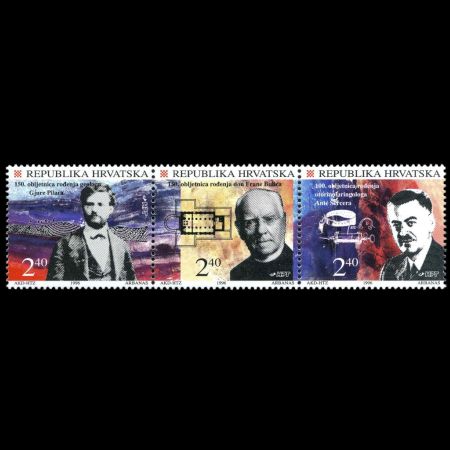
On October 4th, 1996, Croatian Post and Telecommunications issued the set of three stamps "Anniversaries of Croatian Science".
These stamps issued in se-tenant Mini-Sheet of 12 stamps arranged in 4 rows of 3 stamps.
Gjuro Pilar was born in Slavonski Brod in 1846.
After completing his education at grammar school in Osijek and Zagreb he studied natural sciences in Brussels, where he also received his doctoral degree at the age of 22.
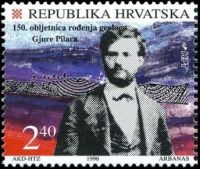 |
| Gjuro Pilar on stamp of Croatia 1996 |
He was engaged in many geological disciplines: paleontology, mineralogy, petrology, coal deposits, geodynamics and hydrogeology of Karst.
He was also engaged in studies regarding mining, mining law, geodesy, astronomy, meteorology and archeology.
He also participated in the founding of the Croatian National Science Association, the Croatia Mountaineering Association and, in 1885/6, together with some friends, he founded and registered the first chess club in Zagreb; he also organized a "trial tournament", the first modern Croatian chess tournament based on the model of European chess contests.
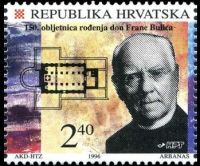 |
| Gjuro Pilar on stamp of Croatia 1996 |
He attended grammar school in Dubrovnik and completed his medical studies in Graz and Prague. He specialized in otolaryngology in Zagreb and later in Prague and Vienna.
He started working on the Medical Faculty of the Otolaryngologic Clinical Hospital in Zagreb in 1920. Later he became its administrator and soon also associate professor.
In 1946, he became head of the department of the otolaryngologic department of the Sisters of Mercy Hospital.
Owing to his reputation the department was given the status of the otolaryngological clinical hospital of the Medical faculty in 1964.
Sercer published 170 scientific papers, among which include important works in the field of otolaryngological propaedeutics and clinical treatment, plastic surgery of the nose and ear, oral surgery and tonsilar problems.
He experimentally tested and proved that the nose is not simply a passive tube serving for the passage of air, but an active and complex respiratory organ.
His method of presenting the infrastructure of the nose through decortication attracted great attention abroad. He was among the first in Europe to treat otosclerosis by surgery and he also worked out a special theory about the etiopathogenesis of this illness.
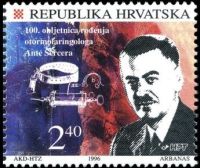 |
| Frane Bulic on stamp of Croatia 1996 |
He studied theology in Zadar, was ordained as priest in 1869 and in the same year started the study of classical philology and Slavonic studies in Vienna.
Afterwards he also studied classical archeology. He actively worked as a researcher, preservationist and writer of numerous scientific and expert works. He acquired his scientific experience on the archeological sites in Greece, Asia Minor, Egypt and Syria, working together with the eminent European archaeologists of that time.
He undertook research of ancient and Old-Christian monuments of ancient Salona and discovered several hundreds of epigraphs as well as the Old-Christian graveyard in Vranjic.
In 1891 he discovered a stone with an inscription of Prince Trpimir in Rizinice near Solin, and later also discovered the ruins of the monastery and church of the Benedictines whom Trpimir invited to Croatia.
In Bijaci near Trogir he found the foundations of Trpimir's church that was dedicated to St. Martha and then in Majdan near Solin. He found the graveyard dating from the times of the Croatian national dynasty.
Of particular importance is his research on the island on the river in Solin, Otok, where he discovered the sarcophagus of the Croatian queen Jelena from the year 976.
Products and associated philatelic items
| FDC | Mini-Sheet | First Day Sheet (with text in Croatian and French) |
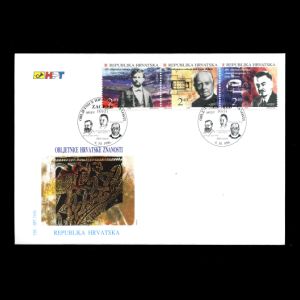 |
 |
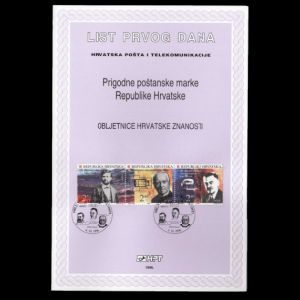 |
| First-Day-of-Issue Postmark | ||
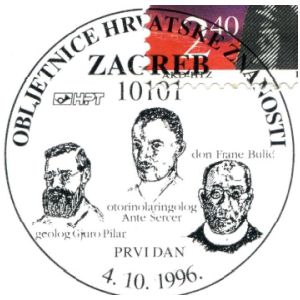 |
|
|

|
References
Technical details and short description of the stamps:Croatian Post (the article isn't available anymore), Colnect.
Acknowledgements
Many thanks to Dr. Peter Voice, PhD Department of Geological and Environmental Sciences, Western Michigan University, USA, for review of a draft of this article.| <prev | back to index | next> |